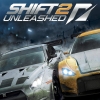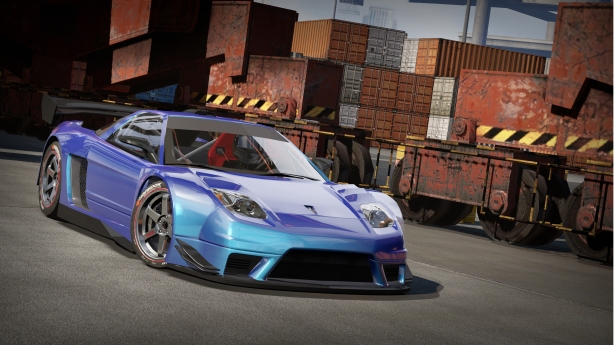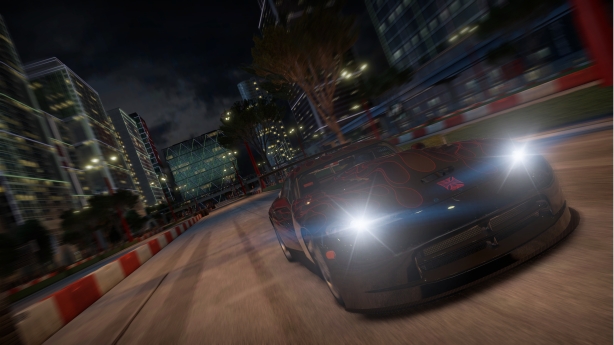Shift 2: Unleashed Review
Developer: Slightly Mad Games
Publisher: Electronic Arts
Available on: PlayStation 3, Xbox 360, PC (Reviewed on Xbox 360)
We spend all of our lives admiring beauty. We photograph stunning scenery, we heap praise onto vivid and exciting imagery in films and we gaze at models and actors with a heady mix of lust and envy. But it’s all a little pointless, isn’t it? Beautiful things look terrific, but apart from fleeting pleasure, what does it really give us? Beauty is a quality that sits at the surface.
Driving games are all about what is underneath the bonnet. How does it feel? How does it drive? These are the questions that define the modern driving game. Shift 2: Unleashed poses a slightly different question. What if how a driving game looked affected how a driving game drives? Now that is interesting!
STORY: Just like its predecessor, story interludes are kept to a minimum in Shift 2. Some establishing cutscenes outline that you are a junior race driver trying to work through the ranks, from showroom cars right up to modern race cars, by driving and winning a variety of different events.
New events are explained to you by Vaughn Gittin Jr, tubby superstar of the Formula D drift racing league, and other “notable” luminaries from some of the more obscure racing leagues from around the world. Their interviews are all very serious and desperately uncool but Vaughn and chums do their best to present tutorials on drifting and works racing as if they were rock stars. Fortunately these interludes are brief, and whilst being noteworthy for how cringe-making they are, do little to spoil the game’s presentation or flow.
It should go on the record, Vaughn Gittin Jr is not the beauty being referred to in the introduction of this review. That is a face only mothers could love. Mothers who love chubby men with awkwardly shaved goatee beards.
GRAPHICS: It seems odd, in some ways, to think of innovation when it comes to graphics. Year-on-year, graphics improve, but it is an iterative process, with change only really perceptible when you pick up and play a game that is half a decade old and notice how imperfect it looks, especially compared with your memory. It is to the immense credit of the Shift series that it really does innovate, with its visuals and its art design, and Shift 2: Unleashed builds onto this brilliantly.
The cockpit view is where every player should be doing their driving in Shift 2. The cockpit is dynamic and exciting. At high speeds or when slipstreaming (you won’t see the word “drafting” here) an opponent, the interior of the car blurs, and focus pulls tight on the scenery and the cars in front of you, giving the racing a very unique tension and sense of speed. Slamming on the brakes snaps the focus back into the car, and the feeling of being pulled forward by your momentum is a palpable one. Both effects combine to give a phenomenal sense of speed and focus to the driving, leaving the cockpit views of alternative titles feeling static and lifeless by comparison. Mistakes and crashes are treated with blurred vision, high contrast black and white visuals and a violent disorientated viewpoint, not only brilliantly representing the force of these collisions but also punishing the player in a way that is completely in context with racing. No collision goes unpunished, and no punishment is just an arbitrary penalty or overly harsh damage. Clever thinking and new ideas in the Shift 2 art design profoundly improve how the game plays. It is what all games should strive for.
The tracks, in particular, feel truly alive. Each has a unique personality that changes with the time of day that they are being driven on. Bright days see the player dealing with sunlight glinting off the tarmac, the glare stealing the vital visual cues of corner entry, racing line, and altering the player’s driving style.
The car models are solid but probably the least interesting part of the visual package, looking stunning neither on track nor when on show in the garage. They don’t let the side down though and it is the overall art design, innovative and unique, that makes this a tremendous looking game.
SOUND: The audio, particularly during crashes and when wheel-to-wheel with rival racers is grippingly good. Engines shout, growl and whine with the anger you would expect from 600bhp racing engines. Couple that with a surprisingly unobtrusive licensed soundtrack and you have an audio package that fits perfectly into the game. A good rule in racing games is that the less you notice the audio, the better job it is doing of complementing the on-screen action, and the Shift 2 audio flawlessly complements the superb visuals.
GAMEPLAY: Beautiful interactive art design and vicious audio aside, Shift 2 is a driving game and developers do have to get the basics right; how does it handle? Driving the cars in Shift 2 is a challenge, but not an unfair one. Particularly early in the game, cars tend to feel slippery on entry into slow corners. Even when the dynamic racing line is green it is tough to attack the apexes at a decent speed. Fast corners and straights maintain that slippery characteristic, small corrections with the steering wheel can often lead to chain reactions where the car becomes a 200mph Catherine wheel as it flies off the track. With time comes mastery however, and Shift 2 rewards practice and proves that it is a challenging handling model, not an unfair one. The handling always keeps the player involved, and because the car never feels like it is on rails, victory and its rewards (often new cars, but usually new paint and rim options) is always hard earned. Equally, mistakes are punished fairly, within the context of the race, usually using the blurred crash vision to remind you that walls will always come off better in a collision than your car.
Opponent AI is excellent. Opponents aggressively fight to hold position, weaving and blocking to keep the player from grabbing the initiative into corners and they aren’t afraid to go flying up the inside line if the player gets a little defensive with the brakes. Most impressive, the AI shows great awareness of what is going on. Many times, after a foray onto the grass, on returning to the track AI cars would scatter to protect their vehicle from damage.
The developers have made sure that all aspects of Shift 2 are as accessible as possible. The game is loaded with clear tutorials which make some of the more nuanced events (particularly the delicate throttle and steering interplay of drift) much more approachable. Upgrading and tuning, often a black hole that sucks in time and effort and spits out absolutely nothing tangible, is clear and useful. Repercussions of upgrades are illustrated onscreen with adjustments to top speed, handling rating and the overall Performance Index; a vital measure that will be used on the speedwall to show everyone else what you drive. Tuning has one of two modes; simple and advanced, and both are explained using plain English. Different save slots let you experiment with your garage without ruining hard earned supercars.
Just as with the art design, there are some good ideas in the gameplay too. Correct driving is rewarded with XP; driver ratings rise faster when players overtake cleanly, rather than bouncing other drivers into the wall. Starts are a cross between Mario Kart and F1 2010, the player needing to balance the throttle then apply the power at the perfect moment to get a good launch. It is the fact that it is clear what you are doing, and that you are rewarded for your execution, that makes it a good inclusion, and an example of the effort that has gone into making this driving simulation accessible.
The solid driving model, surrounded by a number of refined ideas and the brilliantly integrated art and sound design, makes Shift 2 an absorbing drive but also a unique experience to racing games. Which, in a genre that has become defined by recycled paradigms, is a thing of beauty.
MULTIPLAYER: One minute you are driving round a track, racing players from all around the world, with almost no lag and control responsiveness that would be more at home on a LAN game. The next, you are being spun off the track, again, by someone who has got bored and is driving around the track in the wrong direction, or has rammed you off the road for fun.
Multiplayer in Shift 2 has some moments of incredible execution, but also moments where you are left to wonder how something so obvious got missed. For example, the net code felt superb and the ability to see your Autolog time in comparison to the fastest lap of the race adds another layer to the competition. However, the game doesn’t place restrictions on the amount of racers that can play on a specific track so twelve cars can line up on the grid of the tiny, wall-lined Riviera Monument Loop course. Which, of course, turns into a destruction derby at the first hairpin. Also, despite trying to balance opponents, if you have a small garage it is totally possible for you to ruin a race by choosing a car that is too fast or too slow for the race, removing any semblance of competition.
What that leaves players with is an online game whose enjoyment, despite excellent technical execution, is utterly dependent on the people you meet up with online, and by and large, the people you meet online are idiots.
LONGEVITY: Autolog again scores points here. The speedwall doesn’t just give opportunities to compare lap times, it also shows what your friends are driving, how hard they are tuning and upgrading their cars, and what you have left to achieve and experiment with. The Autolog system is at the tipping point, a version of it will be in every driving game on the planet within the next year or so, because it makes games so social. There are too few games now that encourage you to share a sofa with friends and compete over great games, and Autolog is the closest you can come to enjoying that mindset in an empty room. Autolog aside, progression through the main game is linear and linked to the player’s level and their XP. Despite this sequential unlocking of races, the player always has a choice and a variety of events (drifting, retro cars, endurance races) at their finger tips.
The use of both XP and Autolog seems to be an interesting contradiction. On one hand drivers rightfully should compare their abilities using their speedwalls, but on the other drivers are given an arbitrary level to state their ability. In a driving game, where a driver’s pace above all else is king, it would have been terrific if Slightly Mad Studios had found a way to jettison the RPG-style player levels, (which reward slogging away, repetition of races and perseverance) and commit to the Autolog philosophy (which rewards driver pace, tuning cars and practice, practice, practice), unlocking events and comparing drivers online not by their level but by their victories, lap times on particular circuits and what is in their garage.
Methodology aside, their are loads of tracks (played in various daylight scenarios), an array of ridiculous hyper cars, a fun and lengthy career and the twin pillars of solid multiplayer and Autolog. Shift 2: Unleashed will keep you busy for as long as you want it to.
VERDICT: Beauty is perfect when it is more than skin deep. When a developer has the skill and confidence to make advances in art design that are more than just vistas and visual effects, when they actually fundamentally alter the way you approach playing a game, then beauty takes on a whole new meaning.
It is a shame that Slightly Mad weren’t more ingenious with the multiplayer portion of the game, as that is still saddled with the issues that have plagued driving games for some time. None of this detracts from the fact that Shift 2: Unleashed, with its innovations, refinements and the shared idea of Autolog, combined with a very solid handling model and a variety of tracks and cars, is one of the best single player driving experiences available on any system.











